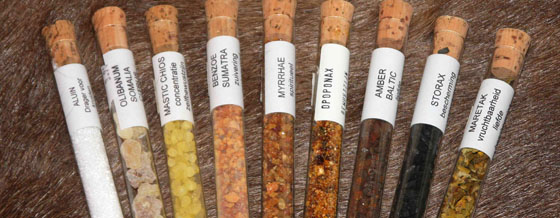| HOME | HISTORIC COSTUMES | FAIRS | WORKSHOPS | CONTACT |

| Cherubijn Incense: all natural resins & herbs.
A lot of resins and herbs can be used as an incense. And of course combining them in recipies can be even more fun!
ATELIER CHERUBIJN offers a wide range of natural and pure ingredients to make your own incense. These are the BOTANICAL products as they are made by the plant itself and directly collected from it. THIS IS THE REAL STUFF! We do not sell cheap resins with artificial perfumes (or even dyes!) added to it. So for example do not ask me for Jasmin-resin. It does not exist, the Jasmin plant does not produce resin. Many shops do offer it but it is a perfumed resin. So you do not know where that perfume came from or what the properties of the resin they used are. And be aware that other resins they offer might be fake as well.
A true resin has a botanical name which tells you exactly from what type of plant it comes from. Then you can find out the composition of the resin and what the properties of that resin are. These can be determined by chemical analysis.
So the properties of resins are based on scientific evidence. Some resins make excelent varnish, others have a nice fragrance or even medicinal properties. Plants make resins to protect themselves from fungi, bacteria or virusses, or from being eaten. They also use them to seal off places of injury. And we can use the stuff to our own advantage! The anti-bacterial parts of a resin for example can make a good cleansing incense. There can be stimulants in resins that help you concentrate or meditate. But also relaxants to help you calm down or feel at peace. For you sceptics: the stuff that gives cannabis the properties it's so much apreciated for is a resin!
And now you may understand the importance of using true botanical resins instead of the cheaper stuff that just smells like it.
For many starters all the different names for incense ingredients can be very confusing. So I have compiled a list of resins and herbs that are often used as incense. It states the Latin name, but also the common name in Dutch, English or German. Some plants mentioned are not used as incense but have other ritual importances. And some are mentioned just for the purpose of comparisson. Also not all herbs and ingredients in the list are on offer. I do not sell mushrooms, cannabis or other prohibited substances. But those products have earned a place on this list because of their long historic relevance and are mentioned in many ancient text and recipes.
For an alphabetical incense ingredient list click one of the links below:
LATIN •
NEDERLANDS •
GERMAN •
ENGLISH
|
